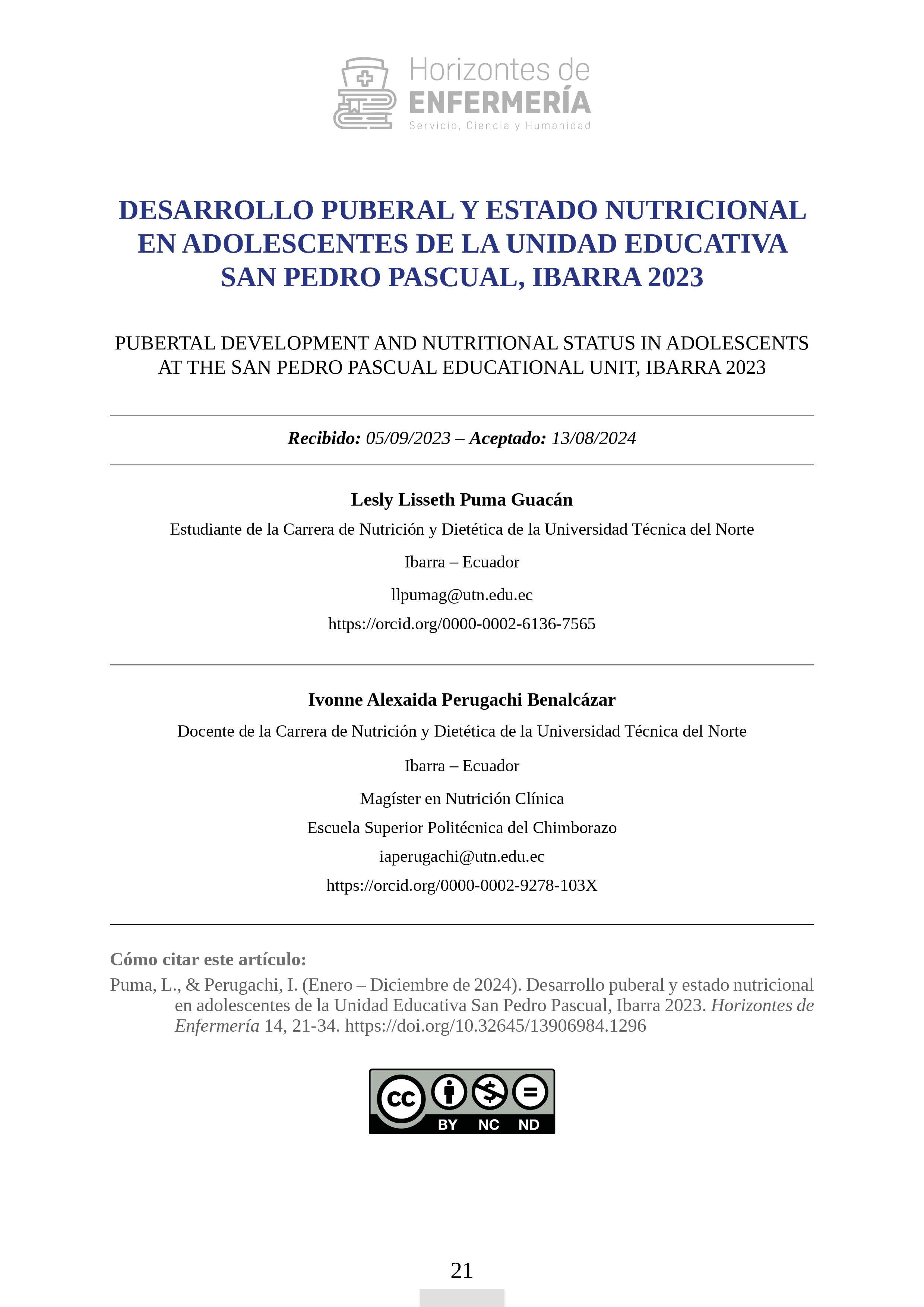Pubertal development and nutritional status in adolescents at the San Pedro Pascual Educational Unit, Ibarra 2023
DOI:
https://doi.org/10.32645/13906984.1296Keywords:
pubertal development, nutritional status, adolescentsAbstract
BMI is a recommended indicator to assess nutritional status in adolescents; however, puberty should be considered during adolescence. The objective of the study was to determine the pubertal development and nutritional status of adolescents from the San Pedro Pascual Educational Unit, Ibarra. This research, which was descriptive, quantitative, and cross-sectional in nature, focused on a population of 256 adolescents aged 12 to 15 years, with a sample size of 71. Exclusion criteria: students whose parents did not sign the informed consent. The study encompassed a range of variables, including nutritional status (BMI/age and height/age), sociodemographic characteristics, and pubertal development. A variety of instruments, such as surveys, Tanner booklets, and anthropometry forms, were used to gather comprehensive data. The use of the anthropometric software WHO Anthro Plus, along with data analysis in Microsoft Excel 360 and EPIINFO 7.2.5, ensured the thoroughness and accuracy of our methodology. The results indicate that the mean of the anthropometric indicators indicate normality, adequate height (99%), and 63% have a eutrophic state; however, women have higher percentages of overweight and risk of overweight; men are located in pubertal stages 1, 2 and 3; while women are in stages 3 and 4, mostly. Conclusions: There are no similarities in BMI by stage or age in any sex; however, in women in the more mature stages 3 and 4, more similar BMI values prevail because the BMI in women increases as sexual maturation increases, regardless of chronological age; although, in men with a higher Tanner stage, the BMI averages decrease.
References
Agüero, G., & Berner, E. (2023). Estadios de Tanner y orquidometría de Prader en varones adolescentes. Estudio descriptivo transversal. Archivos Argentinos de Pediatría, 121(2), 1-7 https://doi.org/10.5546/aap.2022-02717
Burrows, R., Díaz, N., & Muzzo, S. (2004). Variaciones del índice de masa corporal (IMC) de acuerdo al grado de desarrollo puberal alcanzado. Revista médica de Chile, 132, 1363-1368. https://www.scielo.cl/scielo.php?pid=S0034-98872004001100004&script=sci_arttext#tab3
Cando, F., Martínez, D., & Pozo, M. (2018). Antropometría 2 Reportes de la ENSANUT (Vol. 3). https://www.ecuadorencifras.gob.ec/documentos/web-inec/Bibliotecas/Libros/Reportes/Reportes_ENSANUT_Vol3_Antropometria.pdf
Food and Agriculture Organization of The United Nations (2019). Panorama de la seguridad alimentaria y nutricional en América latina y el caribe 2019: hacia entornos alimentarios más saludables que hagan frente a todas las formas de malnutrición. FOOD & AGRICULTURE ORG. https://www.fao.org/3/ca6979es/ca6979es.pdf
Fondo de las Naciones Unidas para la Infancia (2019). Estado mundial de la infancia 2019: Niños, alimentos y Nutrición. https://www.unicef.org/media/62486/file/Estado-mundial-de-la-infancia-2019.pdf
Fondo de las Naciones Unidas para la Infancia (2022). Investigación sobre el estado de implementación de las políticas públicas de entornos saludables para la prevención del sobrepeso y obesidad con un enfoque en la promoción de práctica de actividad física [Archivo PDF]. Unicef. https://www.unicef.org/ecuador/sites/unicef.org.ecuador/files/2022-08/1.%20TDRs%209177070%20Investigaci%C3%B3n%20actividad%20f%C3%ADsica.pdf
Grande, M. del C., & Román, M. D. (2021). Nutrición en la primera etapa del ciclo vital: embarazo, postparto, infancia y adolescencia. Editorial Brujas. https://elibro.net/es/lc/utnorte/titulos/219957
Guerrero, A., & Sánchez Jaeger, A. (2009). Índice de Masa Corporal según grado de desarrollo puberal en varones venezolanos. Anales Venezolanos de Nutrición, 22 (1). http://www.analesdenutricion.org.ve/ediciones/2009/1/art-4/ Consultado el: 22/03/2023
Martínez-Aedo Ollero M. J., & Godoy Molina E. (2019). Pubertad precoz y variantes de la normalidad. En García Cuarteto, B., Ferrer Lozano, M., Arroyo Diez, F. J., Alija Merillas, M., Cardona Hernández, R., & Fernández Ramos, M. C. (Coords.), Protocolos de Endocrinología (págs. 239 - 252). https://www.aeped.es/sites/default/files/documentos/15_pubertadp.pdf
Meza-Aldana, M. T., Briceño, Y., Gómez-Pérez, R., Zerpa, Y., Camacho, N., Martínez, J. L., & Paoli, M. (2018). Desarrollo puberal en niñas y adolescentes de la ciudad de Mérida, Venezuela: comparación con datos de 1982 y asociación con crecimiento, estado nutricional y estrato socioeconómico (estudio Credefar). Revista Venezolana de Endocrinología y Metabolismo, 16(3), 179-193. https://www.redalyc.org/articulo.oa?id=375557570005
Molina Alvarado, J. A., & Córdova Montesinos, D. A. (2020). Edad de aparición de la menarca en la ciudad de Cuenca-Ecuador [Tesis de grado]. Universidad del Azuay. Repositorio Institucional de la Universidad del Azuay. http://dspace.uazuay.edu.ec/handle/datos/10327
Organización Mundial de la Salud. (2021, 9 de julio). Obesidad y sobrepeso. Who. https://www.who.int/es/news-room/fact-sheets/detail/obesity-and-overweight
Pozo Román, J. (2020). Pubertad normal. https://www.pediatriaintegral.es//wp-content/uploads/2020/xxiv04/05/n4-231e1-10_RB_Pozo.pdf
Rueda-Quijano, S. M., Amador-Ariza, M. A., Arboleda, A. M., Otero, J., Cohen, D., Camacho, P. A., López Jaramillo, P., Rueda-Quijano, S. M., Amador-Ariza, M. A., Arboleda, A. M., Otero, J., Cohen, D., Camacho, P. A., & Jaramillo, P. L. (2019). Concordancia de la evaluación del desarrollo puberal mediante la escala de Tanner entre adolescentes y un médico entrenado. Revista Peruana de Medicina Experimental y Salud Pública, 36(3), 408. https://doi.org/10.17843/rpmesp.2019.363.4099
Torres, M. F., Luna, M. E., Garraza, M., Cesani, M. F., Luis, M. A., Quintero, F. A., Navazo, B., & Oyhenart, E. E. (2020). Menarca y estado nutricional en niñas del periurbano de la ciudad de La Plata, Argentina. Archivos Latinoamericanos de Nutrición, 69(3), 149-156. https://doi.org/10.37527/2019.69.3.003
Zermeño Ugalde, P., Gallegos García, V., Gaytán Hernández, D., & Castro Ramírez, R. A. (2020). Relación del índice cintura-talla (ICT) con cintura e índice de cintura cadera como predictor para obesidad y riesgo metabólico en adolescentes de secundaria. Respyn Revista de Salud Pública y Nutrición, 19(3), 19-27. https://doi.org/10.29105/respyn19.3-3

Downloads
Published
Issue
Section
License
Copyright (c) 2024 Lesly Lisseth Puma Guacán , Ivonne Alexaida Perugachi Benalcázar

This work is licensed under a Creative Commons Attribution-NonCommercial-ShareAlike 4.0 International License.
El autor mantiene los derechos morales e intelectuales de su obra, autorizando a la editoruial de la revista revista Horizontes de Enfermería ladifusión y la divulgación de su contenido con fines estrictamente académicos y de investigación, sin fines de lucro.





